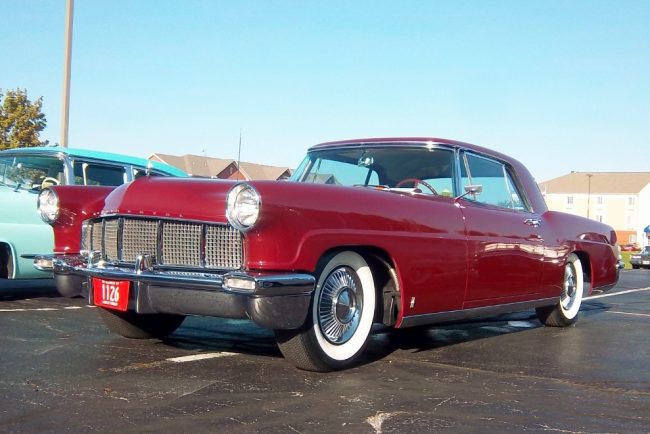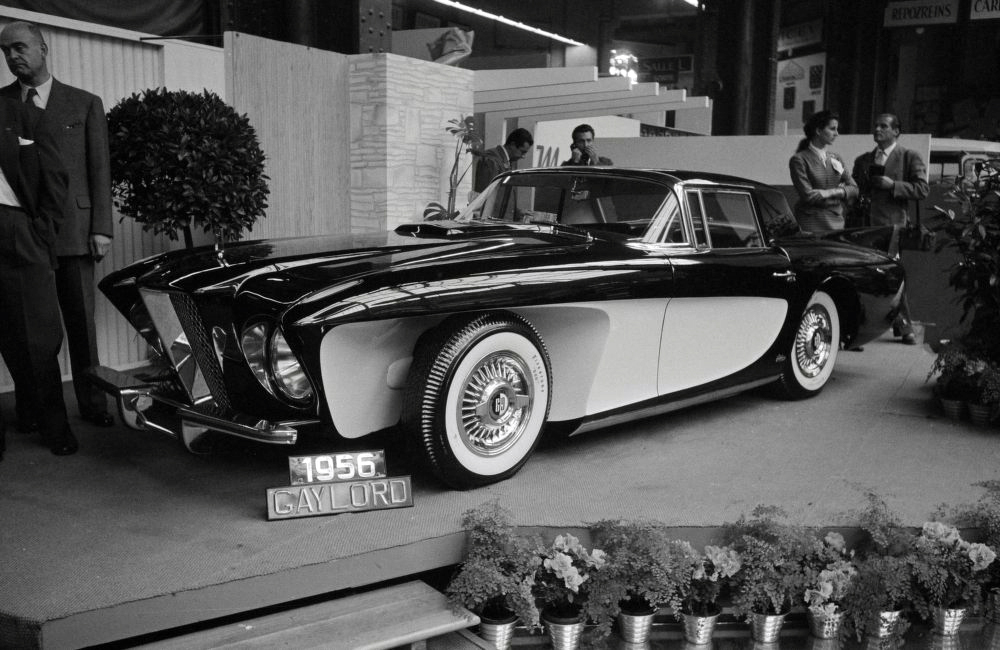Malcolm Bricklin and John DeLorean are well known to this audience, but do the names James and Edward Gaylord ring a bell? Probably not. Even so, the brothers Gaylord built one of the more interesting cars of its time. Or more specifically, three of them.

The story starts with the brothers themselves, who had the good sense to be born into money. Their father was the inventor of the bobby pin, which made him an extremely wealthy man. His son Edward eventually stepped in to run their Chicago-based family business, known as Gayla, quite successfully. Both he and his brother, James, who operated out of Scottsdale, Arizona, had been lifelong car fanatics, having grown up with Packards, Pierce-Arrows, Stutzes and Duesenbergs gracing the family driveway.

Alex Tremulis
As with many a car guy, the desire to design and bring to production a namesake vehicle (which will, of course, be revolutionary) was overwhelming, but these brothers actually had the wherewithal to pursue their dream. According to the designer Alex Tremulis, he was working as chief designer at Tucker when Jim Gaylord visited him one day, proclaiming his desire to build “the ultimate sports car” and stating his intention to have Tremulis design it. Over the next five years, nothing happened as far as the car was concerned as Tremulis moved on to Kaiser-Frazer and then to Ford Motor Company. There, Jim Gaylord visited him a second time, promising to build his car before mid-1955 and seeking Tremulis’s help. Because Ford took a dim view of its designers taking on freelance projects, Tremulis refused; however, he referred Gaylord to a talented freelance designer, Brooks Stevens of Milwaukee, who accepted the design assignment.

We’ll address the…well, controversial, styling a bit later, in order to concentrate on the real story here, the Gaylord’s engineering. Given the technology available in the mid-1950s, the car’s mechanicals are nothing short of amazing. The brothers wanted a high-performance chassis, but one refined enough to totally isolate noise and vibration. Jim proceeded to construct a center chassis frame of chrome and molybdenum tubes, then attached steel channel perimeters and a rigid steel platform. The interior portions of the channels were rustproofed, and all tubes and channels sealed, thus making the whole affair condensation-resistant. By comparison, the suspension looked dead conventional: coils/wishbone in front, leaf springs and a live axle in back. Even here, the brothers took things a step further; the front suspension featured rubber bushings twice the size of any other car’s, while the rear springs boasted permanent moly-disulfide lubrication and leather covers–a full decade before other manufacturers would offer no-lube chassis.

Initially, power came from a 331 CID Chrysler hemi-head V8 fitted with two four-barrel carbs. Later, GM’s Ed Cole convinced Jim Gaylord that the 365 cid, 305 hp Cadillac V8 was lighter and quieter, and the Caddy engine powered the second and third Gaylords. Jim also planned to offer an optional supercharger, but the project never reached that point. Other mechanicals included a GM Hydra-Matic transmission and power steering, whose feel could be regulated via a hydraulic servo controlled by a dash-mounted knob. Specially designed VDO gauges were set into a Siamese-wood instrument panel, and a Heuer chronometer was mounted on the console.

As for the styling, the Gaylords wanted “a modern car with classic overtones”, in Jim’s words, which necessitated compromises. The first (Paris show) car, for instance, featured gigantic Lucas P-100 headlights that gave the front end the countenance of an angry insect. Production models used conventional quad headlights.

It’s fair to surmise that Stevens went out of his way to keep the brothers happy despite his own judgment. The finished design shows a hint of clamshell front fenders; concave side panels;squared-off wheel wells; and freestanding wheels and tires.

Of course, there was the de rigueur wraparound windshield, and in back were tailfins, beneath which was a bright ribbed panel that concealed a slide-out spare tire.

The piece-de-resistance, however, was the Gaylord’s retractable hardtop. Pushing a dashboard-mounted button set into motion a sole electric motor that lifted the deck lid on two struts. The top then lifted and slid into the trunk via a chain drive. It was a model of simplicity compared with Ford’s seven-motor-setup for the 1957-59 Skyliner.
Public showings encouraged the Gaylords, who had started taking orders from such luminaries as actors Dick Powell and Bill Holden, auto magnate Edgar Kaiser, and former Egyptian King Farouk. In the end, however, only three complete cars were built: the first show car, and two subsequent revised models.

With seemingly bright prospects, what did the Gaylord in? Production problems presented a major hurdle. For instance, Luftschiffbau Zeppelin of Fredricksburg, Germany, which had won the contract to build the cars, failed to deliver specified designs. The brothers sued L-Z, and the lawsuit caused Jim Gaylord to suffer a nervous breakdown; citing health reasons, his family eventually persuaded him to abandon the idea of building a car.

1956 Mark II, owned by friends of Klockau.
Then there was pricing. Originally projected to cost $10,000–the same as a contemporary Continental Mark II–the projected price rose quickly to $15,000, then to $17,500. That’s a lot to gamble on an unknown quantity.

Of the three Gaylord cars, the first was destroyed; the second disappeared somewhere in Europe, where it still might exist; and the third was donated to the Early American Museum in Florida, its last known home.



















11 Comments
This was a good read. I think the real reason for failure of this car was that the USA was not a nation of rich, idle playboys but of professional and company men. Driving something so garish would call into question their judgement. The key to their success was people trusting their judgement. A different world today of course.
Interesting the idea of trying to get beyond levels of smoothness and isolation offered by regular American cars. Normally we hear of attempts to improve them in terms of handling precision. I can only think of Rolls Royce attempts with the 65 Silver Shadow. With them going to IRS and a Citroen style suspension proved to be not the answer import fans might have expected even with typical American style weights and ample insulation. It points out something that the car mags of the day missed. At the better domestics there really was a lot of serious engineering going on to extract the best ride possible from what cursory glances by the sneering drive by crowd would write off as a standard suspension design. Hence Cadillacs and Oldsmobiles rode better and quieter than Chryslers and AMC Ambassadors.
We’ll address the…well, controversial, styling a bit later, in order to concentrate on the real story here, the Gaylord’s engineering. Given the technology available in the mid-1950s, the car’s mechanicals are nothing short of amazing.
Maybe for you. But it’s looks were 30 years out of date. “It’s fair to surmise that Stevens went out of his way to keep the brothers happy despite his own judgment.” Have you seen some of Stevens work when given free reign? George Barris on steroids.
Brooks Stevens was a one trick pony if he wasn’t reigned in. Kind of like Robin Williams. If you could keep Williams under control you’d could get fantastic acting out of him. If not, you got “ROBIN WILLIAMS”. Same for Stevens. If a little bit of makeup helps, Stevens would use a pound. He did his best work for clients who didn’t have a lot of money to spend and they made sure that what he came up with was build able.
I have to wonder if Stevens didn’t use ideas from the Gaylord for his later Excalibur, which was a more attractive design because the Excalibur was based on a retro design (MB SLK) with some modern elements (i.e. smaller tires and lower stance). In contrast, an the Gaylord rather unsuccessfully blended some retro design elements to a “modern” design. I also see some improved Gaylord elements in Steven’s later work cleaning up the finned up Studebaker Hawk and turning it into the Gran Turismo.
I can see a design resemblance in the Jeep grills. “How about this?” “We don’t have the money”. “How about this?” We don’t have the money”. “How about this?” “Yeah, we have the money for that.” I think he did his best work for poor clients. The Jeep grills lasted forever in one form or another.
There are a lot of themes that later appeared again those Grand Prix based Stutz’ from the 70’s too.
I was thinking the same thing about Stevens’ Studebaker Hawk GT, particularly the shape of the rear fenders (sans fins) and the formal roofline.
The front end looks Facel Vega – ish to me .
I wonder how many could have actually been sold other than to celebrities .
-Nate
Maybe this car was a little ahead of its time. By 1958, GM and Ford were selling gaudy and gadget-laden gin palaces with wheels on a par with what the Germans sell today. I like the mid-engine location of the Gladiator, as it suggests that this was a car meant to go around corners. It also suggests that they were thinking about the weight of the originally-specified Chrysler hemi. If you’ve ever heard the story of the genesis of the Nash-Healey, I could of sworn it involved GM refusing to supply Donald Healey with Cadillac V8s. I wonder why they didn’t want to be involved with a car maker that had some potential for success.
From what I understand, at the time of the Nash Healey germination Cadillac didn’t have much excess manufacturing capacity for supplying engines to outsiders. Nash apparently got involved because Donald Healey and George Mason (head of Nash) happened to be on the same boat going from the UK to New York and came to some informal agreement during the trip.
I didn’t realize the Healey project began a significant five years sooner. It explains GMs relative willingness to supply engines.
I can’t vouch for the Cadillac side of your story, except to say that GM was reticent about offering any help. The Nash/Healey saga has been pretty well detailed, a matter of willingness on both gentlemens part and the two guys being together at the right time and place.